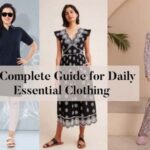Have you ever wondered what your clothes are really made of? Or how they impact our planet and the people who make them? In today’s world, there’s a growing awareness about sustainability, and that includes what we wear. “Eco-friendly materials” in clothing are fabrics that are made with less harm to the environment and often with better social practices. Choosing these materials is a big step towards a more responsible and sustainable wardrobe.
This guide will help you understand what makes a material eco-friendly, introduce you to some of the best sustainable options out there, and give you tips on how to make greener choices when you shop.
Why Material Choice Matters (The Problem with Regular Clothes)
Every piece of clothing has a journey, from raw material to your closet and eventually, to where it ends up. Many traditional fabrics have a surprisingly large negative impact:
- Conventional Cotton: It’s soft and natural, but growing it uses a huge amount of water (thousands of liters for just one t-shirt!) and often relies heavily on harmful pesticides and fertilizers that pollute soil and water.
- Polyester & Nylon (Synthetics): These are made from petroleum, a non-renewable resource. Their production is energy-intensive, and they shed tiny plastic particles called microfibers every time they’re washed. These microfibers end up in our oceans and even our food chain.
- Dyeing and Finishing: Many dyeing processes use harsh chemicals that can pollute water and harm workers.
- Waste: The fast fashion cycle means millions of tons of clothes are thrown away each year, ending up in landfills where they can take hundreds of years to break down.
Eco-friendly materials aim to reduce these problems at different stages of a garment’s life.
Common Eco-Friendly Materials (And Why They’re Good)
Here are some of the most widely used and recognized eco-friendly fabrics:
- Organic Cotton:
- What it is: Cotton grown without synthetic pesticides, fertilizers, or genetically modified (GMO) seeds.
- Why it’s eco-friendly: It reduces water pollution, protects soil health, and is safer for farmers and surrounding ecosystems. It often uses less water than conventional cotton in its growth process.
- Feel: Just as soft and breathable as regular cotton.
- Recycled Cotton:
- What it is: Made from pre-consumer (fabric scraps from factories) or post-consumer (old clothes) cotton waste.
- Why it’s eco-friendly: It diverts textile waste from landfills, saves water and energy that would be used to grow new cotton, and reduces the need for new raw materials.
- Feel: Can sometimes feel a bit rougher than virgin cotton, but technology is improving its softness.
- Linen:
- What it is: A natural fiber made from the flax plant.
- Why it’s eco-friendly: Flax requires very little water, pesticides, or fertilizers to grow. It’s naturally strong, durable, breathable, and fully biodegradable (breaks down naturally).
- Feel: Known for its crisp feel that softens beautifully with wear, and its lovely drape.
- Hemp:
- What it is: A natural fiber from the cannabis Sativa plant (but not the psychoactive kind!).
- Why it’s eco-friendly: Similar to linen, hemp grows very quickly, requires minimal water and no pesticides. It also improves soil health. It’s incredibly strong and durable.
- Feel: Can be a bit stiff at first, but softens significantly over time with wear and washing.
- Tencel™ Lyocell & Modal:
- What it is: These are brand names for rayon fibers (regenerated cellulose) made from sustainably sourced wood pulp (like eucalyptus, beech, or spruce trees).
- Why it’s eco-friendly: Produced in a “closed-loop” system, meaning almost all chemicals and water used in production are recycled and reused, minimizing waste and pollution. The wood comes from sustainably managed forests.
- Feel: Lyocell is known for its incredible softness, smooth drape, and breathability. Modal is often used for its silk-like softness and resistance to shrinkage.
- Recycled Polyester (rPET):
- What it is: Made from recycled plastic waste, primarily plastic bottles.
- Why it’s eco-friendly: It diverts plastic from landfills and oceans, and its production uses significantly less energy and water compared to making virgin polyester.
- Feel: Similar to conventional polyester – durable, quick-drying, and wrinkle-resistant.
- Recycled Nylon:
- What it is: Made from post-consumer waste like old fishing nets, carpets, and industrial plastics.
- Why it’s eco-friendly: Addresses the massive problem of plastic waste, particularly ocean plastic, and reduces reliance on virgin fossil fuels.
- Feel: Similar to conventional nylon – strong, stretchy, and smooth.
- Ethical Wool & Cashmere:
- What it is: Wool and cashmere from sheep or goats raised under strict animal welfare standards, and where grazing practices protect land health.
- Why it’s eco-friendly: Focuses on animal welfare (e.g., no mulesing for sheep), sustainable land management, and minimizing harmful chemical treatments in processing.
- Feel: Warm, soft, and luxurious, just like conventional wool/cashmere.
Emerging & Innovative Eco-Friendly Materials (The Future is Exciting!)
Scientists and innovators are constantly developing new materials that push the boundaries of sustainability:
- Piñatex (Pineapple Leather):
- What it is: A leather alternative made from the cellulose fibers extracted from pineapple leaves, which are a byproduct of pineapple harvest.
- Why it’s eco-friendly: It uses agricultural waste, is biodegradable, and offers a cruelty-free alternative to animal leather.
- Mylo (Mushroom Leather):
- What it is: A material grown from mycelium, the root structure of fungi (mushrooms).
- Why it’s eco-friendly: It’s grown in a lab using minimal resources, is strong and durable, and is fully biodegradable at the end of its life.
- Orange Fiber:
- What it is: A silk-like fabric made from the byproducts of citrus fruit juice production.
- Why it’s eco-friendly: It upcycles agricultural waste and creates a luxurious, sustainable textile.
- Brewed Protein™ (Spiber):
- What it is: A revolutionary fiber created through microbial fermentation (like brewing beer), engineered to have various properties, including silk-like or wool-like textures.
- Why it’s eco-friendly: It’s lab-grown, reducing reliance on traditional resource-intensive materials, and can be designed for specific uses.
- Algae Fabric:
- What it is: Made from algae biomass, often combined with other natural fibers.
- Why it’s eco-friendly: Algae grows rapidly, requires no land, and can even capture carbon dioxide as it grows.
What to Look For When Buying (Your Shopping Checklist)
When you’re shopping for eco-friendly clothing, keep these points in mind:
- Certifications: These are your best friends! Look for labels like:
- GOTS (Global Organic Textile Standard): Guarantees organic status from raw fiber to finished product, with strict environmental and social criteria.
- Oeko-Tex Standard 100: Ensures textiles are free from harmful substances.
- Fair Trade Certified: Focuses on fair wages and safe conditions for workers.
- Bluesign®: Ensures responsible and sustainable production practices throughout the supply chain.
- B Corp: A broader certification for companies meeting high standards of social and environmental performance.
- Brand Transparency: Does the brand openly share information about where their materials come from and where their clothes are made? A good sign is clear information on their website.
- Blends: Watch out for blends. While some blends (like organic cotton and Tencel) can be great, others (like cotton and polyester) can be difficult to recycle at the end of their life.
- Care Labels: Choose materials that don’t require excessive washing or special dry cleaning, which can be energy or chemical intensive.
Beyond Materials: A Holistic View of Sustainable Clothing
Remember, choosing an eco-friendly material is a crucial step, but true sustainable fashion is about more than just the fabric. It also includes:
- Durability and Longevity: Clothes designed to last are inherently more sustainable.
- Ethical Production Processes: Even if a material is eco-friendly, the people making the clothes should be treated fairly.
- Circular Design: Can the garment be repaired, reused, or recycled?
- Buying Less, Choosing Well: The most sustainable garment is the one you already own. Invest in versatile, quality pieces you truly love and will wear for years.
Conclusion: Dress Green, Feel Good
The rise of eco-friendly materials in clothing is a positive and exciting change in the fashion industry. By understanding what these materials are and why they matter, you can make more informed choices that benefit both your wardrobe and the planet. From the soft comfort of organic cotton to the innovative potential of mushroom leather, there are more ways than ever to dress sustainably. Every conscious choice you make contributes to a greener, fairer, and more beautiful future for fashion.


